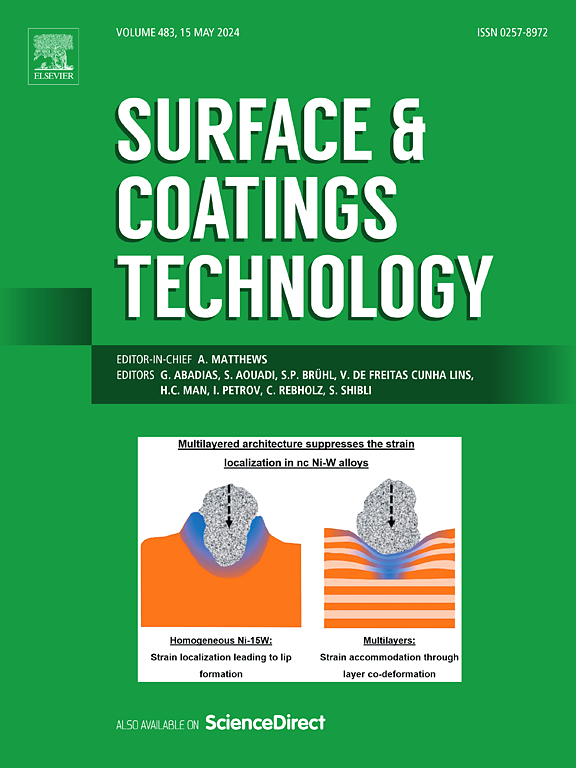提高高熵合金涂层热障应用的复合策略
IF 5.3
2区 材料科学
Q1 MATERIALS SCIENCE, COATINGS & FILMS
引用次数: 0
摘要
高熵合金(HEAs)在结构和功能上的广泛应用引起了人们的极大兴趣,例如新开发的金属基热障涂层。然而,热导率的高温敏感性给他们的实践带来了挑战。为此,我们提出了一种复合策略来解决这一问题,并合成了添加钇稳定氧化锆(YSZ)的AlCoCrFeNiTi HEA涂层。复合涂层的金属基体具有简单的体心立方(BCC)结构和200-500 nm超细晶粒的微观结构特征,而分散的YSZ添加剂具有典型的四方结构,对其初始含量具有较高的变形/沉积敏感性。由于液滴的快速淬火和HEA薄片表面形成纳米级氧化膜,非均质薄片形成弱接触界面。层状沉积结构中适量YSZ的加入有效地抑制了径向热流,使HY10 (HEA-10%YSZ)复合涂层在800℃时的导热系数极低,仅为3.63 W/(m·K),其主要机制是抑制了电子导热系数。同时,HY10复合涂层保持了2.90 MPa·m2 /2的高断裂韧性,与单片HEA涂层相当,表明脆性陶瓷颗粒对力学性能的破坏有限。所提出的复合策略为改善HEA涂层的热障应用铺平了道路,其调控机制为未来旨在制定广泛金属基复合涂层设计的工作提供了灵感。本文章由计算机程序翻译,如有差异,请以英文原文为准。
Composite strategy for improving the thermal barrier application of high-entropy alloy coating
High-entropy alloys (HEAs) attracted great interest in a wide range of structural and functional application, such as the newly developed metal-based thermal barrier coatings. However, the high temperature-sensitivity of thermal conductivity made a challenge for their practice. Herein, we proposed a composite strategy to address this problem and synthesized AlCoCrFeNiTi HEA coatings composited with yttria-stabilized zirconia (YSZ) additions. The metallic matrix of composite coatings inherits a simple body-centered cubic (BCC) structure and a microstructure feature of ultrafine grains in size of 200–500 nm, whereas the dispersed YSZ additions depict a typical tetragonal structure and a high deformation/deposition-sensitivity to their initial content. The heterogeneous splats form a weak contact interface due to the rapid-quenching of droplets and the nanoscale oxide film formed on the surface of HEA splats. The moderate YSZ additions with lamellar deposition structure effectively hinder the radial heat flux, granting the HY10 (HEA-10%YSZ) composite coating an extremely low thermal conductivity of 3.63 W/(m·K) at 800 °C, whose underlining mechanism is disclosed as the suppression of electron thermal conductivity. Meanwhile, the HY10 composite coating maintains a high fracture toughness of 2.90 MPa·m1/2 that is comparable to the monolithic HEA coating, demonstrating a limited damage of brittle ceramic particles on mechanical properties. The proposed composite strategy paves the way for improving the thermal barrier application of HEA coatings and the regulating mechanisms provide an inspiration for future works aiming to formulate the design of extensive metal-matrix composite coatings.
求助全文
通过发布文献求助,成功后即可免费获取论文全文。
去求助
来源期刊

Surface & Coatings Technology
工程技术-材料科学:膜
CiteScore
10.00
自引率
11.10%
发文量
921
审稿时长
19 days
期刊介绍:
Surface and Coatings Technology is an international archival journal publishing scientific papers on significant developments in surface and interface engineering to modify and improve the surface properties of materials for protection in demanding contact conditions or aggressive environments, or for enhanced functional performance. Contributions range from original scientific articles concerned with fundamental and applied aspects of research or direct applications of metallic, inorganic, organic and composite coatings, to invited reviews of current technology in specific areas. Papers submitted to this journal are expected to be in line with the following aspects in processes, and properties/performance:
A. Processes: Physical and chemical vapour deposition techniques, thermal and plasma spraying, surface modification by directed energy techniques such as ion, electron and laser beams, thermo-chemical treatment, wet chemical and electrochemical processes such as plating, sol-gel coating, anodization, plasma electrolytic oxidation, etc., but excluding painting.
B. Properties/performance: friction performance, wear resistance (e.g., abrasion, erosion, fretting, etc), corrosion and oxidation resistance, thermal protection, diffusion resistance, hydrophilicity/hydrophobicity, and properties relevant to smart materials behaviour and enhanced multifunctional performance for environmental, energy and medical applications, but excluding device aspects.
 求助内容:
求助内容: 应助结果提醒方式:
应助结果提醒方式:


